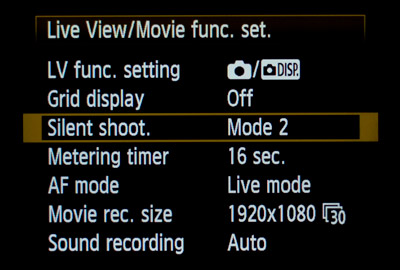EXCERPT page containing first few paragraphs. 2024-04-24 19:09:25
UA_SEARCH_BOT_compatible_botmozilla/5.0 applewebkit/537.36 (khtml, like gecko; compatible; claudebot/1.0; +claudebot@anthropic.com) @ 18.223.107.149
For full access, subscribe here. Or click title to login. ![]()

Canon Silent Shoot Mode for Zero Vibration
Canon’s Silent shoot mode 2 makes Live View a great way to shoot long telephoto lenses without inducing vibration; make sure the image is stable on the LCD (no vibration visible), then release the shutter using a remote release.
Some Canon DSLRs, including the Canon 5D Mark II, offer an electronic first curtain shutter feature, which means that the shutter need not close (and then reopen) to begin an exposure.
In Live View mode, making an exposure with Silent shoot = Mode 2 means the shutter starts open, then exposure is made. No vibration whatsoever during the exposure!
This approach eliminates the vibration of opening the first shutter curtain, which can cause blur at low shutter speeds, especially with long telephoto lenses. Of course, you do have to use a remote release, so that pressing the shutter release does not vibrate the camera.
Article continues for subscribers...
Diglloyd Making Sharp Images is by yearly subscription. Subscribe now for about 13 cents a day ($50/year).
BEST DEAL: get full access to ALL 8 PUBLICATIONS for only about 75 cents a day!
Diglloyd Making Sharp Images articulates years of best practices and how-to, painstakingly learned over a decade of camera and lens evaluation.
Save yourself those years of trial and error by jump-starting your photographic technical execution when making the image. The best lens or camera is handicapped if the photographer fails to master perfect shot discipline. High-resolution digital cameras are unforgiving of errors, at least if one wants the best possible results.
- Eases into photographic challenges with an introductory section.
- Covers aspects of digital sensor technology that relate to getting the best image quality.
- Technique section discusses every aspect of making a sharp image handheld or on a tripod.
- Depth of field and how to bypass depth of field limitations via focus stacking.
- Optical aberrations: what they are, what they look like, and what to do about them.
- MTF, field curvature, focus shift: insight into the limitations of lab tests and why imaging performance is far more complex than it appears.
- Optical aberrations: what they are, what they look like, and what to do about them.
- How to test a lens for a “bad sample”.
Intrigued? See Focusing Zeiss DSLR Lenses For Peak Performance, PART ONE: The Challenges, or (one topic of many) field curvature.

